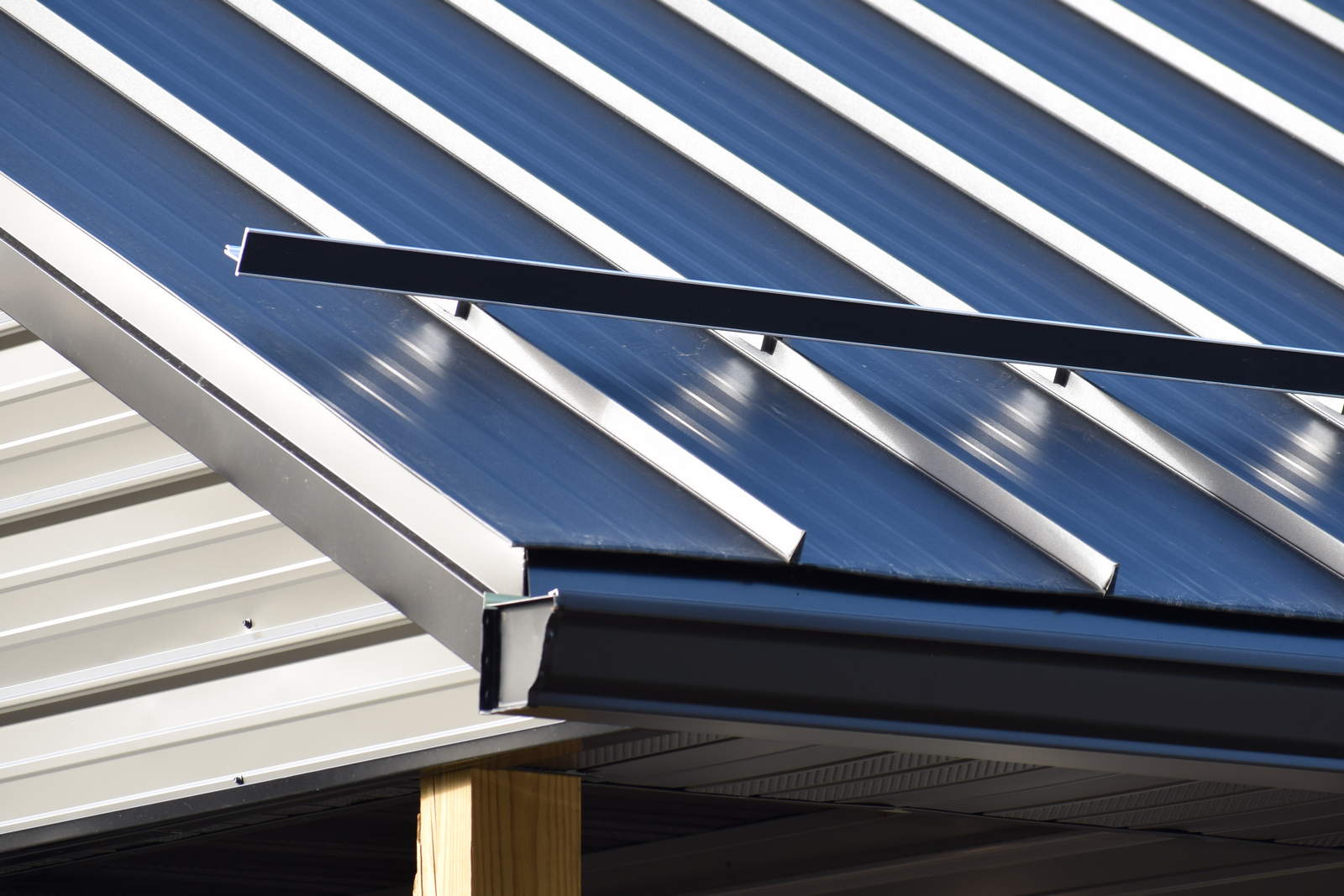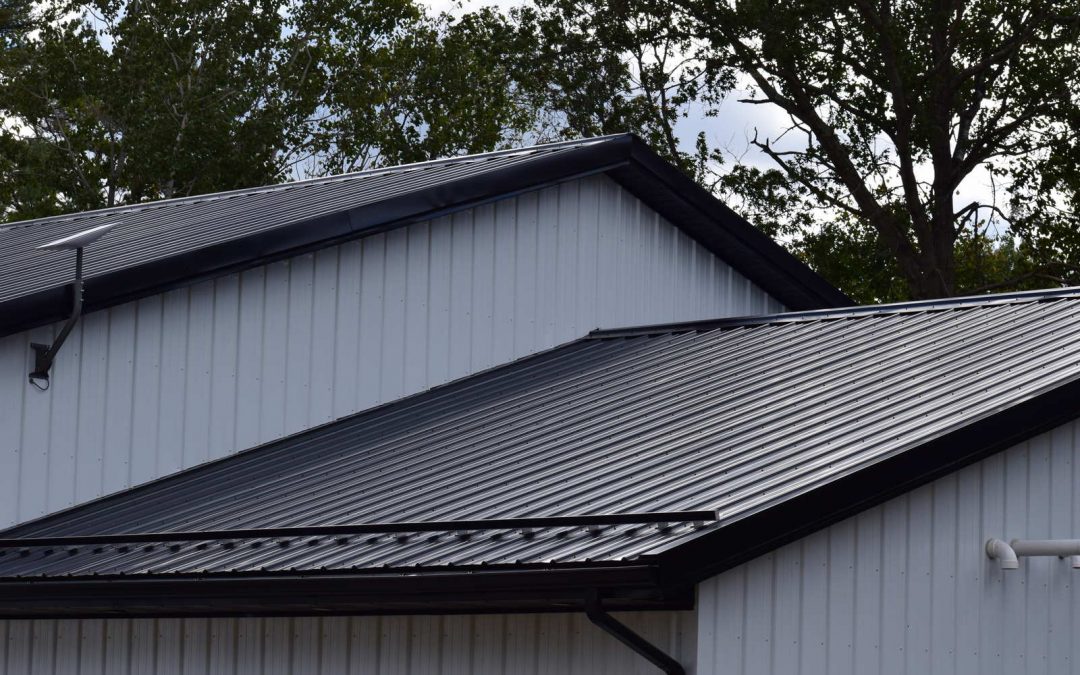Homeowners may question the cost of installing a metal roof when it’s time to replace those old worn out asphalt shingles. First they are going to need to know the difference between standing seam and exposed fastener system, in order to understand the cost difference between the two types of metal roofing systems.
Exposed Fastener Metal Roofing & Its Advantages
Exposed Fastener metal roofing panels are attached directly to the trusses or roof decking (typically plywood or OSB). The panels are attached with screws, which go directly through the panel from the outside, creating a hole in the panel at every screw. These holes in time may allow moisture to penetrate into the building if the screws are not attached correctly. This type of system is more affordable – not only in terms of material costs, but also due to cheaper installation labor costs. Let’s elaborate on some of the advantages.
More Affordable
One of the biggest advantages of exposed fastener panels is that they cost less than standing seam. Depending upon the thickness gauge of the panels being used, and the paint system used on the panels, the cost savings could be at least 50% for exposed fastener vs standing seam. There are several factors that attribute to its affordability.
Less Accessories Required
Since exposed fastener roofing systems are installed just by using fasteners (screws), the installer doesn’t need to buy any fastening clips. In addition, less trim and flashing is needed. Standing seam systems require purchasing multiple pieces of trim. Purchasing additional trim and fasteners will substantially increase the overall cost of the roof, not only in terms of materials, but also labor costs.
Metal Gauge
Exposed fastener panels are typically made in a 24, 26, or 29-gauge metal, where standing seam is more often seen in a heavier 22-gauge or 24-gauge metal. The higher the gauge number, the lighter and thinner the metal. This means that exposed fastener panels are usually thinner, and therefore less expensive than standing seam panels.
Easier Installation
An exposed fastener roof is easier and faster to install than a standing seam roofing system because it requires fewer steps. The exposed fastener system installation requires a simpler skillset, where more contractors would be qualified to install exposed fastening systems. Having more contractors to choose from, coupled with less labor time means that exposed fastener systems are generally less expensive to install. A larger pool of contractors to choose from makes installation bids more competitive and prices down.
DIY Installation
An easier installation process makes exposed fastener panels a great opportunity for a DIY (do it yourself) project. You will save even more money this way by doing the labor yourself if you feel you’re capable of handling the installation.
Material Availability
Exposed fastener panels are typically more common and easier to find. They’re sold in almost any home improvement store, including All American Do it Center in Tomah, Sparta and Richland Center Wisconsin. In some cases, you may find a much greater panel and color selection when going directly to the manufacturer like All American Steel.
Standing Seam Roofing & Its Advantages
Fewer Fastener Replacements
Some standing seam systems will use clips to secure the panels, while others may use fasteners. For the kind that has fasteners, having them concealed ultimately protects them from the elements. By not being exposed to water, wind, or debris, they are less prone to corrosion and will not have to be replaced as often as the systems with fasteners that are left exposed.
Concealed Fasteners Are More Weathertight
By having the fasteners hidden or using clips where there are no penetrating holes through the roof, standing seam systems are more resistant to leaks. On the contrary, exposed fasteners may leave gaps between the fasteners and the panels. This allows water to come in and can eventually lead to leaking and overall damage.
Expanding And Contracting of Metal
With temperature changes from hot to cold, metal will expand and contract. As the metal panels go through the heating and cooling process year after year as the seasons change, it is likely to eventually affect the tightness of the roof’s fastening screws.
Improved Looks
While aesthetics may be subjective, the look of standing seam is most often preferred due to curb appeal of sleek appearance.
Suitable For Very Low Sloped Roofing
Standing seam can be installed on a very low sloped roof (1:12 pitch with installation of Butyl Sealant). By contrast, exposed fastener roofing should not be installed on a roof that is less than a 3:12 pitch.
Standing seam can’t be installed on a flat roof (below a .5/12) due to water accumulation that will not have a way to drain off the roof. Eventually, the water will find its way underneath the roofing material resulting in rotting the substrate, color change, or leaks.
If the screws on a standing seam panel become loosened, they are still protected from water as they are concealed. However, loose screws on exposed fastener panels are much more likely to be vulnerable to leaking since they are directly exposed to the elements.
Compatibility with Solar Panels and Snow Guards
The seams of a standing seam roof are very convenient if you plan on installing solar panels. A clamp attaches the solar panels to the seam/leg of the standing seam roofing panels. There’s no need to drill any holes into the roof to accomplish an installation. Other rooftop additions, such as snow guards are easily installed in a similar way.

Which Fastening System Should I Use?
Standing Seam systems are best for those who:
Want a panel that requires less maintenance.
Have a low roof slope condition.
Live in an area prone to severe weather.
Want a modern design with curb appeal.
Have a flexible budget.
Exposed fastener systems are best for those who:
Want to spend less money.
Want a more informal/industrial looking roof.
Could do the installation themselves or are looking for an easier DIY project.
The nuts and bolts of it: What is the Cost Difference between Standing Seam and Exposed Fastener Panels?
Customers frequently want to know the price difference between metal panels installed with exposed versus concealed fasteners.
While that question may seem very straightforward, many different variables impact the answer. Things like the roof geometry, project location, panel gauge, panel width, roof pitch, and even paint system can impact cost comparisons between the two system types.
With that said, concealed fastener systems (standing seam) generally cost approximately 50% more than a comparable exposed fastener system.
Factors Impacting the Cost Difference
Numerous factors contribute to the roughly 50% cost difference between exposed and concealed fastener panels. To help broaden your understanding, let’s summarize a few of the most significant factors.
Labor. Concealed fastener panels typically cover 16-18” of width, whereas exposed fastener panels routinely cover 36”. That simple difference means the panel manufacturer and the installer experience a significantly reduced efficiency when working with concealed fastener panels during both production and installation. Panels are sold by the linear foot and a narrower panel will cost more as it takes more panels to cover the same area as an exposed fastener panel would.
Packaging. As mentioned previously, packaging requirements vary greatly between the panel styles. Concealed fastener panels require the construction of solid wooden crates. Consequently, part of the 50% estimated upcharge for standing seam style panels is rooted in the additional labor and cost of supplies demanded by the enhanced packaging.
Panel Gauge. As mentioned previously, a heavier gauge of steel used to create standing seam panels is more costly than a thinner gauge of exposed fastener panels.
Justifying the Cost of Concealed Fastener Systems
While the roughly 50% added expense might feel substantial, standing seam systems offer numerous benefits over an exposed fastener system. Since no exposed fasteners are used to attach the panels, concealed fastener panels provide a much lower opportunity for leaks caused by improper fastener installation. As depicted in the illustration below, the washer should be properly seated (not under or overdriven, or crooked) when correctly installed.

Additionally, while the neoprene washers on the fasteners have greatly improved, ultraviolet rays from the sun can still cause them to shrink and crack over time (they generally at least 20 years). When this occurs, water can infiltrate the building. It’s important to note that this problem is easily repaired by simply removing and replacing the fasteners. Consequently, if you’re not opposed to some light maintenance every 20-30 years, the increased cost to install a concealed fastener panel may not be cost-effective for you.
Ultimately, only you can decide if the added 50% expense to move from exposed to concealed fastened panels makes sense for you.
Contact the team at All American Steel today on our website or by calling 608-377-7200 and get an estimate on materials for both an exposed fastener system and standing seam / concealed fastener system. We can do the design work, renderings, materials lists, materials, and delivery to the jobsite. You can also visit our display at the All American Do it Center home improvement stores in Tomah, Sparta, or Richland Center Wisconsin.


